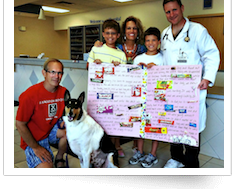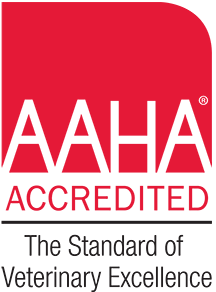Eye Enucleation with Post-op infection
Written by: Nicole S. • 2016 Scholar
Yoshi Brenin
Thursday, May 26th
Yoshi, a six year old male pug, came to Iowa Veterinary Specialties (IVS) with his left eye protruding from the socket. He presented with a history of playing with his housemate which caused the eye to dislodge from the socket.
At presentation, Yoshi had a body temperature of 101.1 degrees Fahrenheit, a heart rate of 130 beats per minute, a respiratory rate of 36 breaths per minute, pink mucus membranes, and a capillary refill time of less than two seconds. Each of these parameters are within their respective normal ranges, indicating that he was otherwise healthy apart from his eye incident. Yoshi weighed 20.7 pounds when he presented.
During his physical exam, Yoshi displayed a proptosed left eye while the right eye remained normal. The remainder of his physical exam was within normal limits. Dr. Bohn discussed Yoshi’s presentation with the owners who consulted to an eye enucleation surgery where Yoshi’s proptosed eye would be removed. This decision was based on the amount of time that had passed between the eye being displaced and the time Yoshi could get to surgery. Due to this length of time, it was unlikely that the eye could be placed back in the socket safely and yield positive results.
Prior to surgery, Yoshi was administered 0.32 mL Buprenex intramuscularly for pain relief. An intravenous catheter was placed and isotonic fluids were started at a rate of 20 mL per hour to provide supportive care before and during the surgery. Yoshi’s packed cell volume, total proteins, and a chemistry panel were checked to ensure Yoshi was able to proceed to surgery without prior complications. His packed cell volume was 47% (normal value: 37-55%), his total proteins read 6.8 g/dL (normal value: 5.0-7.4 g/dL), and his chemistry panel showed normal values (suggestive of a healthy liver, pancreas, and kidneys).
To begin Yoshi’s procedure, he was initially anesthetized with intravenous Propofol before intubating and keeping him unconscious with Isoflurane gas. Yoshi’s blood oxygen saturation, blood pressure, and vitals (temperature, respiratory rate, and heart rate) were recorded every five minutes throughout surgery to ensure he remained stable. Dr. Bohn performed a lateral canthotomy to remove Yoshi’s left globe from the eye socket. Dr. Bohn began by removing the palpebral edges to create fresh margins that would promote healing by primary intension. The conjunctival tissues were bluntly dissected to the medial canthus and the globe was excised and removed. When removing the globe, it is important to not put tension on the optic nerve which connects to the back of the globe. Tension on the nerve can cause blindness in the opposite eye via damage to the optic chiasm. Dr. Bohn placed a gel foam piece in the orbit to promote hemostasis. 3-0 PDS suture was used to close the subcutaneous tissue layer with a simple interrupted pattern and 4-0 Ethilon suture was then used to close the more superficial skin layer. Yoshi’s recovery was unremarkable and an E-collar was placed around his neck to prevent him from rubbing or scratching at his wound. Yoshi was prescribed 50 mg tablets of Tramadol in which he received a half tablet three times a day to control pain. Yoshi was also prescribed Buprenex to take home for ongoing pain management during his initial recovery as well. For antibiotics, he received 125 mg of Clavamox twice daily to prevent infection.
Sunday, May 29th
Yoshi returned to IVS for a checkup because the owners noticed bleeding from the left eye socket and ventral neck swelling. On physical exam, Yoshi’s eye socket had a small amount of serosanguinous discharge from the medial aspect of his incision. The area was cleaned with sterile saline and the site was not actively bleeding. Yoshi was documented for having a mild seroma and no further treatment was needed.
Tuesday, May 31st
Yoshi came back to IVS for severe swelling, discoloration, and pressure around his left eye socket. He had also not eaten all day which was unusual behavior for Yoshi.
During his physical exam, Yoshi had lymph node swelling and some cellulitis. His left mandibular lymph node was noted as enlarged. Yoshi’s left eye socket was significantly swollen and the socket was a purple color with blood-tinged fluid oozing from it. The socket was not bruised when examined. Dr. Gearhart recommended running a Complete Blood Count (CBC) to check his white and red blood cells, prescribing pain medications, and pulling some fluid from the socket for evaluation. Dr. Gearhart’s main concern was that the eye was infected with a bacteria that was resistant to the Clavamox Yoshi was previously prescribed.
Yoshi’s CBC showed an elevated white blood cell count with a high neutrophil value which is indicative of infection. A Buprenex dose of 0.5 mL was administered to control Yoshi’s pain before draining the eye socket with a needle and syringe. A total of 16 mL of blood-tinged fluid was drained from the eye socket. The fluid was highly cellular and cytology revealed a large number of neutrophils and short rod-like bacteria. The socket fluid was outsourced for a culture and sensitivity test to determine if the bacteria was resistant to the Clavamox. The culture and sensitivity test would also show which antibiotics should be used to best control the infection. Yoshi’s owners decided to take him home with different antibiotics to get the infection under control. Dr. Gearhart discontinued the Clavamox and instead prescribed a half tablet of 136 mg Enrofloxacin to be given orally once daily as well as one capsule of 150 mg Clindamycin to be given orally twice daily. Yoshi also received 100 mL of subcutaneous fluids before leaving the hospital to help with his recent unwillingness to eat and maintain his fluid balance.
Monday, June 6th
Yoshi came in for his sutures to be removed from the eye enucleation procedure. His left socket had no swelling or bruising at the time and his antibiotic prescriptions of Enrofloxacin and Clindamycin were refilled for another week to ensure the infection was gone. The sutures were removed and Yoshi’s owners were notified that the culture and sensitivity test was still pending.
Monday, June 13th
The owners were called and notified of the culture and sensitivity results. Yoshi’s culture showed a heavy and pure growth of E. coli that was resistant to the Clindamycin, but susceptible to the Enrofloxacin. Yoshi’s owners noted that Yoshi was doing well and his eye socket had healed.




